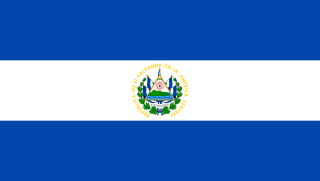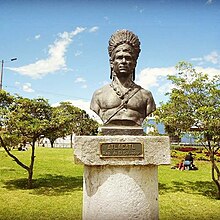
El Salvador, officially the Republic of El Salvador, is a country in Central America. It is bordered on the northeast by Honduras, on the northwest by Guatemala, and on the south by the Pacific Ocean. El Salvador's capital and largest city is San Salvador. The country's population in 2023 was estimated to be 6.5 million.
The history of El Salvador begins with several distinct groups of Mesoamerican people, especially the Pipil, the Lenca and the Maya. In the early 16th century, the Spanish Empire conquered the territory, incorporating it into the Viceroyalty of New Spain ruled from Mexico City. In 1821, El Salvador achieved independence from Spain as part of the First Mexican Empire, only to further secede as part of the Federal Republic of Central America two years later. Upon the republic's independence in 1841, El Salvador became a sovereign state until forming a short-lived union with Honduras and Nicaragua called the Greater Republic of Central America, which lasted from 1895 to 1898.

Pedro de Alvarado was a Spanish conquistador and governor of Guatemala. He participated in the conquest of Cuba, in Juan de Grijalva's exploration of the coasts of the Yucatán Peninsula and the Gulf of Mexico, and in the conquest of the Aztec Empire led by Hernán Cortés. He is considered the conquistador of much of Central America, including Guatemala, Honduras and El Salvador.

The Nahua are an Indigenous group of Mesoamerican people inhabiting the western and central areas of present-day El Salvador. They speak the Nawat language, which belongs to the Nahuan language branch of the Uto-Aztecan language family. There are very few speakers of the language left, which is a reason for the current efforts being made to revitalize it.

The Nahuas are a group of the indigenous people of Mexico, El Salvador, Guatemala, Honduras, Nicaragua, and Costa Rica. They comprise the largest indigenous group in Mexico and second largest in El Salvador. They are a Mesoamerican ethnicity. The Mexica (Aztecs) are of Nahua ethnicity, as are their historical enemies, the Tlaxcallans (Tlaxcaltecs), and the Toltecs which predated both groups are often thought to have been as well, though in the pre-Columbian period Nahuas were subdivided into many groups that did not necessarily share a common identity.

Usulután is a department of El Salvador in the southeast of the country. The capital is Usulután.

The culture of El Salvador is a Central American culture nation influenced by the clash of ancient Mesoamerica and medieval Iberian Peninsula. Salvadoran culture is influenced by Native American culture as well as Latin American culture. Mestizo culture and the Catholic Church dominates the country. Although the Romance language, Castilian Spanish, is the official and dominant language spoken in El Salvador, Salvadoran Spanish which is part of Central American Spanish has influences of Native American languages of El Salvador such as Lencan languages, Cacaopera language, Mayan languages and Pipil language, which are still spoken in some regions of El Salvador.

In a protracted conflict during the Spanish colonization of the Americas, Spanish colonisers gradually incorporated the territory that became the modern country of Guatemala into the colonial Viceroyalty of New Spain. Before the conquest, this territory contained a number of competing Mesoamerican kingdoms, the majority of which were Maya. Many conquistadors viewed the Maya as "infidels" who needed to be forcefully converted and pacified, disregarding the achievements of their civilization. The first contact between the Maya and European explorers came in the early 16th century when a Spanish ship sailing from Panama to Santo Domingo was wrecked on the east coast of the Yucatán Peninsula in 1511. Several Spanish expeditions followed in 1517 and 1519, making landfall on various parts of the Yucatán coast. The Spanish conquest of the Maya was a prolonged affair; the Maya kingdoms resisted integration into the Spanish Empire with such tenacity that their defeat took almost two centuries.
Texistepeque is a city and municipality in the Santa Ana department of western El Salvador. It lies in the center of the department, north of Santa Ana and south of Metapán. It was founded by the Poqomam Maya peoples and conquered by the Pipil people of Cuzcatlan until the Spanish conquest. The meaning of its name comes from Pipil Nawat language and means place of eggs or alternatively mountain of eggs; from Nawat teksis (eggs), and tepec or tepet (mountain) which indicates a place name.
The Xinka, or Xinca, are a non-Mayan indigenous people of Mesoamerica, with communities in the southern portion of Guatemala, near its border with El Salvador, and in the mountainous region to the north.
Nawat is a Nahuan language native to Central America. It is the southernmost extant member of the Uto-Aztecan family. It was spoken in several parts of present-day Central America before Spanish colonization, but now is mostly confined to western El Salvador. It has been on the verge of extinction in El Salvador, and has already gone extinct elsewhere in Central America. In 2012, a large number of new Nawat speakers started to appear. As of today, the language is currently going through a revitalization.

Cuzcatlan was a pre-Columbian Nahua state confederation of the Mesoamerican postclassical period that extended from the Paz river to the Lempa river ; this was the nation that Spanish chroniclers came to call the Pipils or Cuzcatlecos. No codices survive that shed light on this confederation except the Annals of the Cakchiquels, although Spanish chroniclers such as Domingo Juarros, Palaces, Lozano, and others claim that some codices did exist but have since disappeared. Their Nawat language, art and temples revealed that they had significant Mayan and Toltec influence from the ties they had with the Itza in Yucatan. It is believed that the first settlers to arrive came from the Toltec people in central Mexico, mostly Puebla during the Chichimeca-Toltec civil wars in the 10th century AD.
The Atlácatl Battalion was a rapid-response, counter-insurgency battalion of the Salvadoran Army created in 1981. It was implicated in some of the most infamous massacres of the Salvadoran Civil War.

Salvadorans, also known as Salvadorians, are citizens of El Salvador, a country in Central America. Most Salvadorans live in El Salvador, although there is also a significant Salvadoran diaspora, particularly in the United States, with smaller communities in other countries around the world.

The Battle of Acajutla took place on June 8, 1524, between the Spanish conquistador Pedro de Alvarado and the standing army of Cuzcatlan Pipils, an indigenous Nahua state, in the neighborhood of present-day Acajutla, near the coast of western El Salvador.

The Spanish conquest of El Salvador was the campaign undertaken by the Spanish conquistadores against the Late Postclassic Mesoamerican polities in the territory that is now incorporated into the modern Central American country of El Salvador. El Salvador is the smallest country in Central America, and is dominated by two mountain ranges running east–west. Its climate is tropical, and the year is divided into wet and dry seasons. Before the conquest the country formed a part of the Mesoamerican cultural region, and was inhabited by a number of indigenous peoples, including the Pipil, the Lenca, the Xinca, and Maya. Native weaponry consisted of spears, bows and arrows, and wooden swords with inset stone blades; they wore padded cotton armour.

El Salvador–Spain relations are the current and historical relations between El Salvador and Spain. Both nations are members of the Association of Academies of the Spanish Language, Organization of Ibero-American States and the United Nations.

The Nicarao are a Nahua people who live in western Nicaragua and northwestern Costa Rica. They spoke the Nahuat language before it went extinct in both countries.
Gómez de Alvarado y Contreras was a Spanish conquistador and explorer. He was a member of the Alvarado family and the older brother of the famous conquistador Pedro de Alvarado.
The Battle of Tacuzcalco was a battle on 13 June 1524 fought between a Spanish army under the command of conquistador Pedro de Alvarado and Cuzcatlan fighters under Atlácatl.











